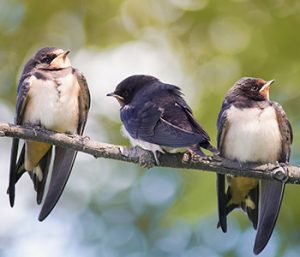Barn Swallows
Biology
The barn swallow is the most widespread swallow in the world. The barn swallow is recognized by its long forked tail. The swallow nests almost always on man made structures.
They fly with quick bursts of straight flight, rarely gliding, and can perform fast tight turns, and dives. When water insects hatch, barn swallows may join other swallows in foraging flocks.
When settled, the barn swallow looks cone shaped, with a slight flattened head, no visible neck. The barn swallow has broad shoulders that lead to long, pointed wings. The tail extends beyond the wingtips and the long outer feathers give the tail a deep fork.
The female can lay anywhere from 2-7 eggs, but normally around 4-5 white eggs that are spotted red. She typically lays 2 broods a year. Incubation lasts between 14-19 days. The chicks will remain in the nest for another 18-23 days while they fledge.
Feeding Preferences
All species of flies make up most of the barn swallow’s diet, along with beetles, bees, wasps, ants, butterflies, moths, and other flying insects.
Transmitted Diseases
Barn swallows carry a variety of diseases: histoplasmosis, encephalitis, salmonella, cryptococcosis and toxoplasmosis. These swallow illnesses are spread by contact with swallow feces, nest materials and dead swallows.
Habits
Barn Swallows often fly low, just a few inches above the ground or water. True to their name, they build their cup-shaped mud nests on man made structures.
Both male and female build the nest cup using mud. They collect mud in their bills and often mix it with grass stems to make pellets. They first construct a small shelf to sit on, then build up the nest’s sides.
Barn Swallow pairs investigate possible nesting spots by flying up and hovering to inspect their possible nesting site. They prefer to nest in eaves, rafters, cross beams of barns, sheds and stables, as well as the underneath bridges, wharfs, and culverts. They may also use nests from previous years if those nests remain intact and not infested with mites or parasites.
These birds feed only when flying They fly lower than many other swallow species hugging the ground or water surface. They catch flies and other prey midair and often follow farm animals, cattle herds, and humans to snag insects. They occasionally feed on disabled or dead insects on the ground. Barn wallows also drink and bathe on the wing, dipping down to touch their belly to the surface of the water for a quick rinse. Males defend a small territory around the nest site and aggressively chase away other males, even grabbing them with their feet and falling to the ground. Individuals or groups of barn swallows chase away predators such as hawks, gulls, or grackles that approach nests. They have also been known to dive down in an aggressive manner towards people and animals when defending their nest.

